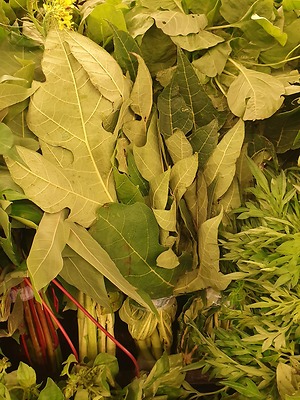


Papaya Leaves
Estimated Inventory, lb : 0
Description/Taste
Papaya leaves are medium to large in size, averaging 50-70 centimeters in diameter and 18-90 centimeters in length, and are broad, flat, and deeply, palmately lobed. The rough, green leaves are thin, pliable, and have prominent yellow veining spreading throughout the 5-9 lobes. The leaves grow on hollow stems in palm-like clusters at the very top of the tree, and each leaf contains a white, milky latex liquid that is emitted when torn. Papaya leaves are crisp, have a fresh, green flavor, and can be extremely bitter, depending on maturity.
Seasons/Availability
Papaya leaves are available year-round.
Current Facts
Papaya leaves, botanically classified as Carica papaya, grow on a small single stemmed tree that can grow up to ten meters in height and is a member of the Caricaceae family. Also known as Pawpaw and Papaw in Australia and the West Indies, Papaya trees grow in tropical climates around the world, recognized by their scar marked stem, and all parts of the tree including the fruit, seeds, and leaves can be consumed. Papaya leaves are a lesser known part of the Papaya tree, shadowed by the fruit, and are used medicinally in teas to aid in digestion.
Nutritional Value
Papaya leaves contain calcium, magnesium, zinc, iron, manganese, and vitamins A, B, C, E, and K.
Applications
Papaya leaves are best suited for cooked applications such as boiling. Commonly boiled and steeped into a tea or tonic, Papaya leaves are a popular medicinal ingredient to assist with digestion. They can also be boiled to remove bitterness and are consumed similar to spinach or are crushed and used to help tenderize meat. In Africa, the stems of Papaya leaves are peeled, grated, and juiced. The mash of the stems is then served with sugar and salt. In addition to culinary applications, Papaya leaf extract can be found in tablet, powder, and tincture form for medicinal use. Fresh Papaya leaves should be used immediately. Once juiced or made into tea, the liquid from the leaves will last up to five days in the refrigerator.
Ethnic/Cultural Info
Rural communities in Indonesia, Sri Lanka, and India use Papaya leaf juice and sap to treat a variety of ailments such as joint pain, eye infections, gastric issues. In some Asian communities, the leaves are rolled up into cigar-like shapes and are smoked, rumored but not proven, to be helpful with asthma. Papaya leaves are also used in these communities for prevention and reduction of symptoms associated with malaria and dengue fever.
Geography/History
While the exact center of origin is unknown, Papaya is believed to be native to southern Mexico, Central, and South America. Papaya then spread through the Caribbean to Southeast Asia during the 16th century in the times of the Spanish exploration and was brought to India and Africa through the Pacific. Today, Papaya is grown in over fifty-seven countries, and the leaves can be found at fresh markets in Asia, Southeast Asia, Australia, Africa, the Caribbean, the United States, Central America, and South America.
Recipe Ideas
Recipes that include Papaya Leaves. One
| YouTube |
|
Buntil Papaya Leaf |
| Juicing For Health |
|
Papaya Leaf Juice |
















